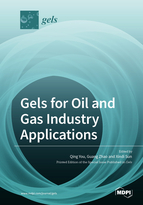Gels for Oil and Gas Industry Applications
A special issue of Gels (ISSN 2310-2861).
Deadline for manuscript submissions: closed (31 July 2022) | Viewed by 23128
Special Issue Editors
Interests: gel; conformance control; temporary plugging; enhanced oil recovery
Special Issues, Collections and Topics in MDPI journals
Interests: profile control; water shutoff; chemical materials; enhanced oil recovery
Special Issues, Collections and Topics in MDPI journals
Interests: gel conformance control; CO2 EOR; CO2 sequestration; chemical EOR
Special Issues, Collections and Topics in MDPI journals
Special Issue Information
Dear Colleagues,
This Special Issue is focused on the application of gels in oil and gas fields to improve hydrocarbon recovery. A broad range of topics will be discussed, including but not limited to field application cases, novel gel development, experimental evaluation of gel performance for conformance control, fracturing, lab- and field-scale numerical simulations, etc.
Gels, such as in-situ gels and preformed particle gels, have been widely used in the oil and gas industry to control excess water production and gas channeling, which contributes significantly to improving hydrocarbon recovery. Based on different application conditions, many novel gels have been developed. The evaluation of the novel gels is crucial since the properties of some polymers can be altered under high temperatures, high salinity, or high CO2 conditions. In addition, due to the complexity of the reservoirs, some gels may perform differently in the field than in the lab. In this case, the experiences gained from field application studies are very valuable for future gel development, evaluation, and application. As a cost-effective method, numerical simulation is used widely in the oil and gas industry to simulate gel treatment, analyze production data, and predict future production after gel treatment. Any studies related to gels for oil and gas field applications can advance the understanding of the gel performance in porous media and large channels, which is of significant importance to the oil and gas industry.
We look forward to the submission of new studies on gel development or gel application in the oil and gas industry. Submissions of experimental or field studies are welcomed.
Note: If you are unable to meet the current submission deadline, please consider our Volume II:
Gels for Oil and Gas Industry Applications (2nd Edition)
Dr. Qing You
Dr. Guang Zhao
Dr. Xindi Sun
Guest Editors
Manuscript Submission Information
Manuscripts should be submitted online at www.mdpi.com by registering and logging in to this website. Once you are registered, click here to go to the submission form. Manuscripts can be submitted until the deadline. All submissions that pass pre-check are peer-reviewed. Accepted papers will be published continuously in the journal (as soon as accepted) and will be listed together on the special issue website. Research articles, review articles as well as short communications are invited. For planned papers, a title and short abstract (about 100 words) can be sent to the Editorial Office for announcement on this website.
Submitted manuscripts should not have been published previously, nor be under consideration for publication elsewhere (except conference proceedings papers). All manuscripts are thoroughly refereed through a single-blind peer-review process. A guide for authors and other relevant information for submission of manuscripts is available on the Instructions for Authors page. Gels is an international peer-reviewed open access monthly journal published by MDPI.
Please visit the Instructions for Authors page before submitting a manuscript. The Article Processing Charge (APC) for publication in this open access journal is 2600 CHF (Swiss Francs). Submitted papers should be well formatted and use good English. Authors may use MDPI's English editing service prior to publication or during author revisions.
Keywords
- development of novel gels
- conformance control of gels
- fracturing of gels
- chemical EOR of gels
- field application of gels









